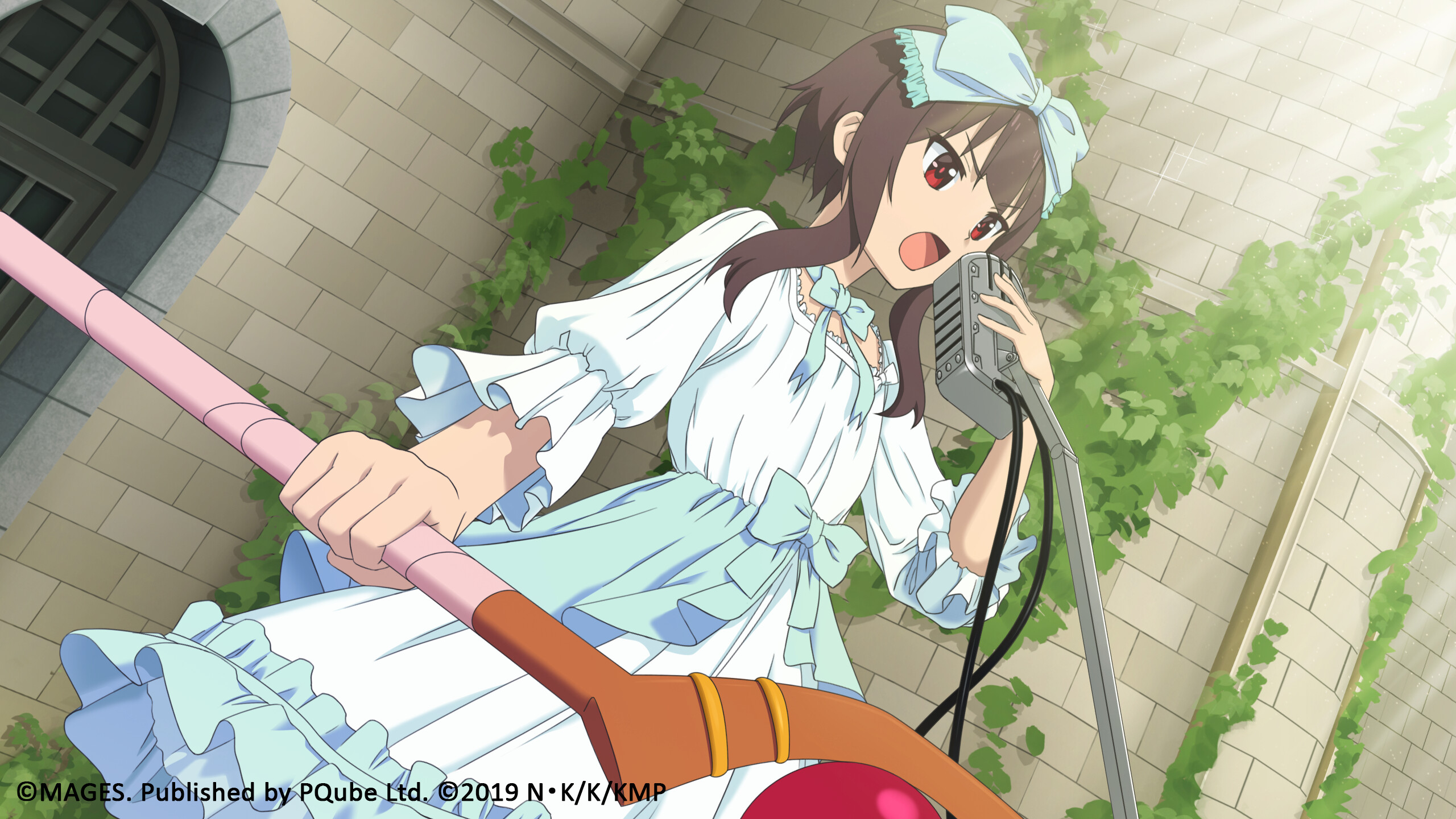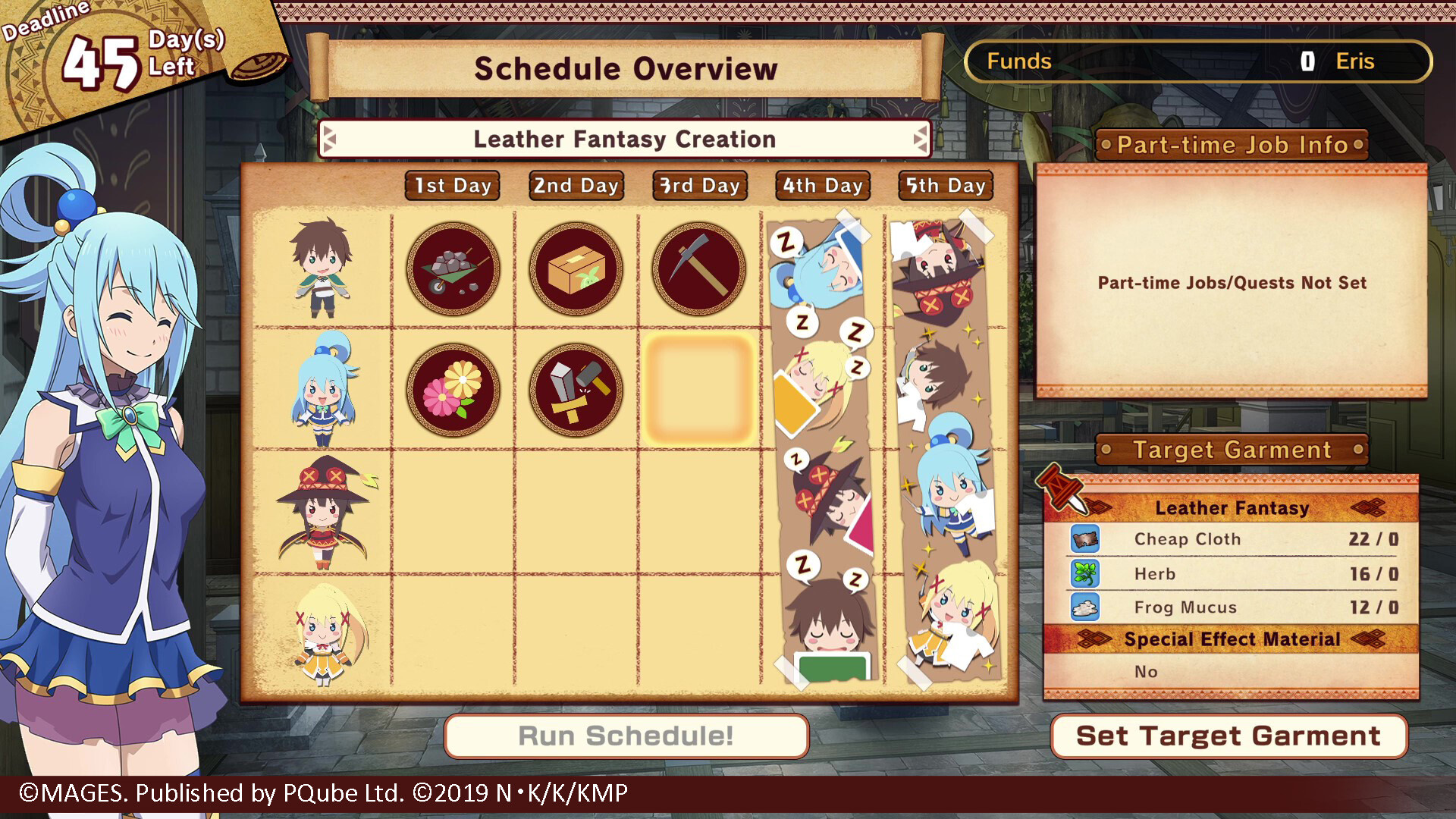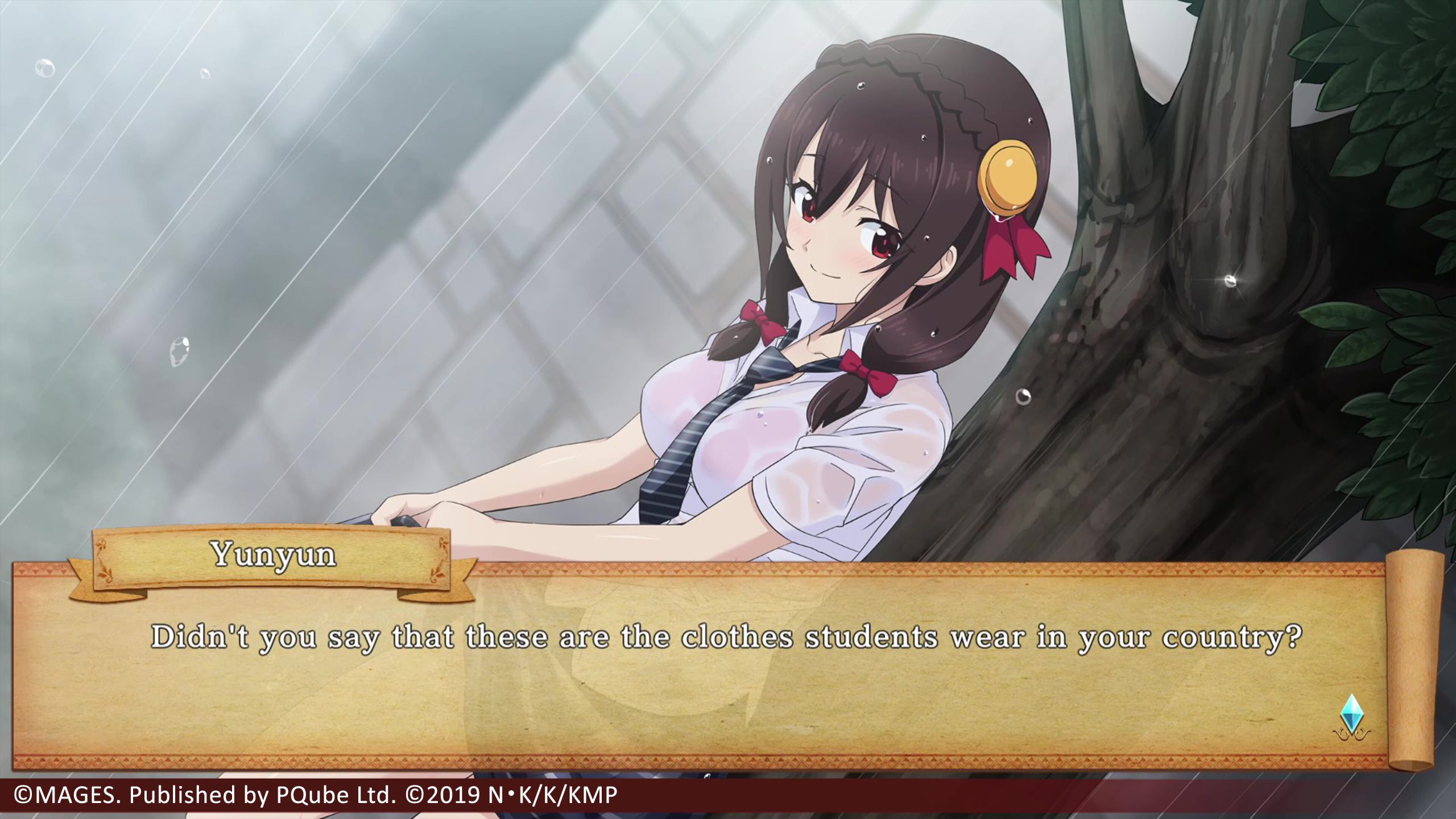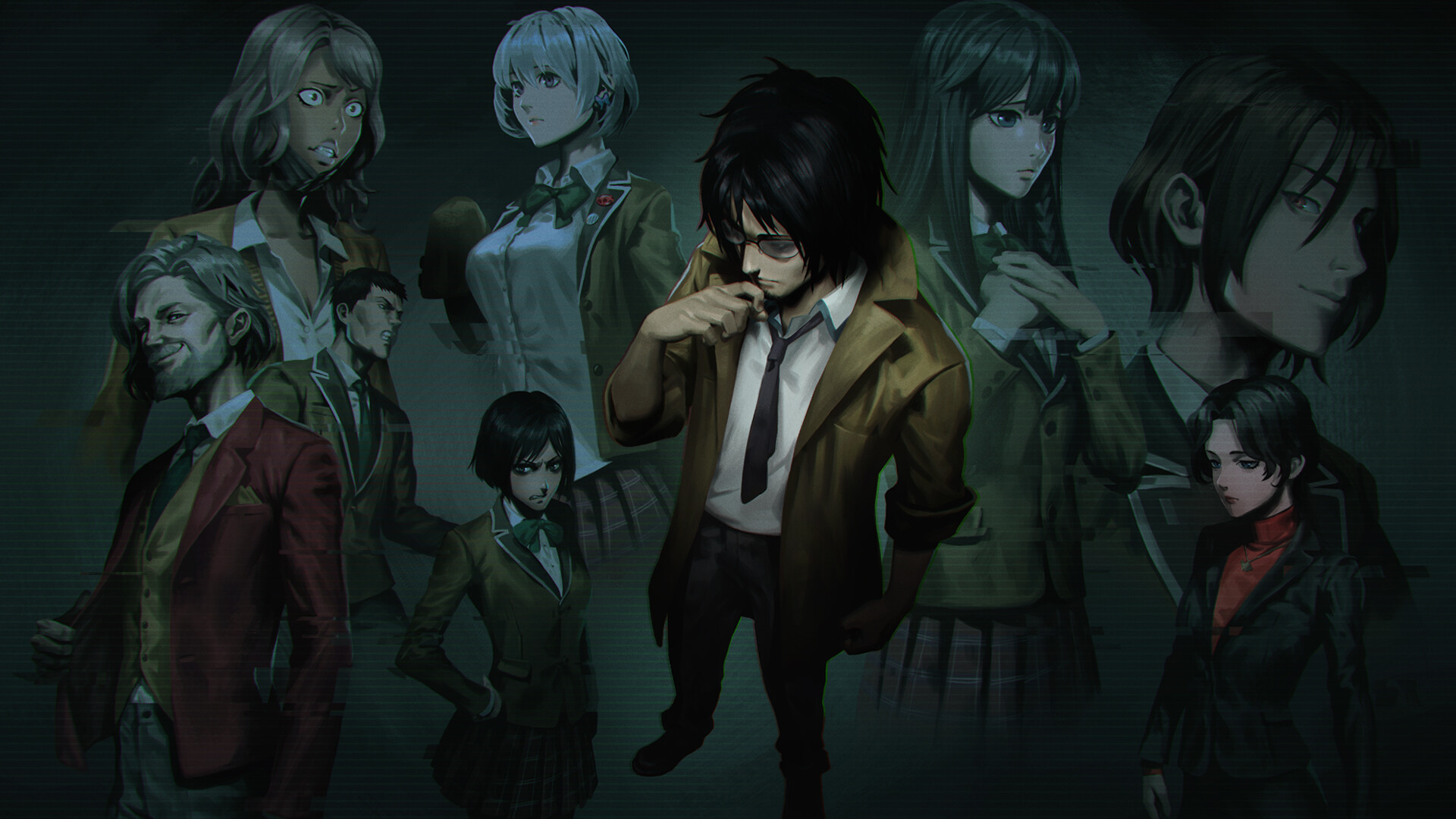Well, Konosuba: Love for These Clothes of Desire certainly has its eye-opening moments. This is a game that likes to get downright dirty in places, and embraces (with gusto) every possible sexualisation trope you can imagine in anime. It has a ball doing so, and as long as isekai-style narratives amuse you, you’ll have a good belly laugh along with it.
It is, for the most part, a visual novel, but it does have some little time management features thrown in for good measure. The narrative is wacky and right out there. There’s a group of “heroes” in a fantasy MMO-style world. They all have highly exaggerated character types. There’s the mage who, uh, blows her load early and wastefully. There’s a warrior that has a masochistic streak (to put that mildly). And so on. These characters discover a magic artefact that allows them to make clothing, but then discover that it’s also cursed and, unless they can break the curse, their personalities will invert themselves. The only way to break the curse is to make clothing, and so they embark on that exact quest.
Konosuba: Love for These Clothes of Desire follows on from a light novel and anime series, and it doesn’t bother filling you in with what went before the game. I didn’t realise that it was a genuine isekai (with the main protagonist having previously existed in the “real world” before being dumped in his little harem) until I’d started researching the game to review it. It doesn’t necessarily matter since the plot of the game is self-contained and so ridiculous that “making sense” was never going to be a priority anyway.
You do need to have a high level of tolerance for writing that is as juvenile as a giggling school boy writing rude notes in his textbook, however. If a sentence like this causes you to roll your eyes, then it’s a safe bet that you can skip this entire game: “In this small chest of mine hides a secret! An innocence and virtuousness that breast-havers can’t ever reclaim!” The game’s humour also tends to be in the service of some pretty straightforward fan service and sexualisation, rather than subversive to it, so consequently the jokes come off as intensely thirsty and pervy. Again, it’s a great time for what it is, but this is by no means humour for everyone.
As a game, Konosuba kind of works like a classic Atelier, I guess. You’ve got a certain number of days to complete quests or undertake jobs, and those activities will yield you materials and money, which you then use to craft a piece of clothing. The timelines and requirements are relatively minimal, and it’s hard to imagine people will struggle too much to craft all the clothing that the main story requires of them. But the break from the visual novel sequences is appreciated, and it’s a nicely structured little system.
As far as the costumes go, you’ll be creating just about everything that you’d expect to see from the sexy Halloween costume stores (as well as swimsuits, of course). School uniforms (white shirt and rainy weather and all), maid and nurse clothing. There are also some side quests that you can complete that take the opportunity to dial things up even further.
If only it didn’t look like it was on the independent end of visual novels. Konosuba’s art is functional and it certainly carries across the idea of the raunch, but it really needed to look more like Date A Live or similar to really sell the idea that it’s sexy to go with the funny. Make no mistake about it, Konosuba wants to convey a playful sexiness through its art – the characters are designed to be more than just vehicles for comedy, and there is an effort to get a lot of detail into key art scenes and the like. The ideas behind the designs and costuming is great. The art team just needed a bigger budget to work with.
Konosuba was a fun project for PQube to localise. It – like the material it’s based on – is by no means classic, but it’s playful, and often laugh-out-loud funny, even if there are times that you wish you didn’t find it quite as amusing as you did.
Buy the hottest games with Amazon.
By purchasing from this link, you support DDNet.
Each sale earns us a small commission.














Disagree with the note on the source material. Definitely the funniest Isekai around and not as heavy on the fanservice. It is, however, mostly really dumb.
Did they get a good laugh out of you, Matt?
I’ve never even seen the source material, hah. Not sure what point I inadvertently made about it, but that wasn’t the intention. I do understand that it’s an excellent satire though. The satire’s a little lost in this one… or perhaps relys on you knowing the source mode.
Still, it’s a very good time! I found plenty to laugh with 🙂
Good to hear! Definitely give the anime a shot if you’re looking for something funny to watch. It’s legitimately laugh out loud funny in just the dumbest ways. Excellent stuff.
I’ll see about the game though, Matt C’s comment about the translation not “getting” the source material makes me much less excited… With so many amazing titles out there it’s hard to pick something that might disappoint…
My biggest issue with this release is the appalling translation. The excuse that “non-Japanese speakers won’t notice, so it’s fine from a business stance” as stated by a lead translator is, frankly, insulting — and I say that as a professional translator myself. More so when there are very basic beginner level Japanese being incorrectly translated. This also might explain why certain parts of the game seemingly fall flat, as the translators have not understood the characters either.
For one earlier example, the translation loses the point that Aqua’s False Fire not only drew new monsters in, but also ones scared away by Megumin jumping the gun and firing off her Explosion early. Or, for that matter, when Kazuma is talking about embracing the masochism; this too, is incorrect. He’s actually wondering when he started thinking that Darkness’s masochism was normal.
I’m only in the first chapter because every other line I’m pulled out of the story by yet another (glaring to Japanese speakers) mistake and perversion of the original story. And this, mixed with the typos, the most astounding being “oufit oufit” in an early tutorial screen, are, frankly, ruining what should have been a fun experience for me.
The only plus side to the English release is that with my worsening eyesight, I can see the text a little more clearly! Which is why I’m putting up with it and not asking for a refund (from my translator stance, I don’t consider the current state to be fit for purpose).
Now, Matt, please, do watch the anime. It ranks as one of my all time favourites.
It’s weird. I’m getting so used to having crappy localisations (particularly from visual novels from Korea and China), that I barely noticed the errors that you’re talking about here. But yes, you’re right. More work could have been done on the localisation.
And thanks for the heads up on the anime 🙂